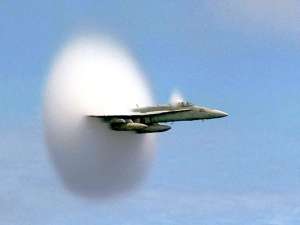|
Add Comment |
|
Support the Museum of Hoaxes BUY MY BOOK or MAKE A DONATION |
|
Main Page |
|
Back to Hoax Photo Test Answers |
Sonic Boom Photo

| A real, unaltered photo taken over the Pacific July 7, 1999 by Ensign John Gay. The plane is an F/A-18 Hornet assigned to Strike Fighter Squadron One Five One (VFA-151). The plane is approaching the speed of sound, causing a vapor cone to form around it. The image is available on a Navy website. |
Comments: most recent posts first
about that jet picture in hoax/real test
"A jet plane caught in the instant that it breaks through the sound barrier and causes a sonic boom"
Picture is real but the text is not correct. It only needs certain pressure and humidity of air to produce that kind of cloud around the aircraft and enough speed (transsonic) so that air in some parts of the aircraft goes faster than sound. Aircraft it self doesn't have to make sonic boom or go through sonic barrier (supersonic). Most of those pictures claim that it's picture of sonic boom, but it is not. Aircraft may accelerate to supersonic speed after that... or may not.
http://www.eng.vt.edu/fluids/msc/gallery/conden/mpegf14.htm
http://www.eng.vt.edu/fluids/msc/gallery/conden/pg_sing.htm
Posted By: Anonymous
Friday, May 02, 2003
It is ironic that you are attempting to debunk hoaxes, yet your "self test" page perpetuates the false idea of a photo of a jet fighter "the instant it breaks through the sound barrier and creates a sonic boom". The vapor cone is a normal pressure/temperature/humidity physical phenomenon that has absolutely nothing to do with the sound barrier. There are websites that show this picture and rave about the miraculous once-in-a-lifetime chances of catching a photo of a plane breaking the sound barrier. They are wrong, the photographer is ascribed improper credit, and your site should debunk it and encourage a rational scientific explanation rather than perpetuate the myth. ref: http://www.wilk4.com/misc/soundbreak.htm
The condensed water vapor is formed by normal variations of humidity, temperature and pressure in the atmosphere. (Check with any college chemistry student re: water phase chart.) When the fighter flies through a particularly humid pocket of air, the increase in air pressure due to the plane's pressure envelope causes the water to instantly condense. Once the plane passes and the pressure releases, the water will just as instantly re-vaporize. It has NOTHING TO DO WITH THE SOUND BARRIER. The faster the plane goes, obviously the the pressure differential is greater, and the effect is more pronnounced, so you don't see it as often with relatively slow-moving commercial jets. The same effect produces contrails, in which case turbulence due to vortexes in the pressure envelope causes the condensed droplets to collide and form larger droplets, so they don't re-vaporize upon return to ambient pressure. In the jet photo there is no apparent vortex, and so, very little droplet collision. Ref: http://www.eng.vt.edu/fluids/msc/gallery/conden/pg_sing.htm
Tom Armstrong
Oakland, CA USA - Thursday, December 19, 2002 at 10:29:47 (PST)
Two comments about the F-14 and the HH-60G. The F-14 is not necessarily caught "At the time it breaks the sound barrier". It is definitely supersonic, but what you are seeing are the sonic shock waves. A sonic boom is created ANY time a plane is supersonic, and occurs when the shock wave passes the observer, not when the airplane does. In this case, at the time the photograph was taken, the photographer would have heard...NOTHING. Two, the HH-60G USAF helicopter is not only digitally altered, but it has also been inverted, the tail rotor and fuel probe should be on the right side of the aircraft.
Chris Lowenstein
Thursday, December 05, 2002 at 20:52:40
Great web site, the Real Hoax test is very weldone I got 6/10 tho, the sonic boom picture is the best!
James Watkin
Newcastle, North East England - Wednesday, December 04, 2002 at 11:02:33 (PST)